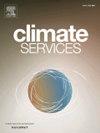Rainfall forecasts, learning subsidies and conservation agriculture adoption: Experimental evidence from Zambia
IF 4
3区 环境科学与生态学
Q2 ENVIRONMENTAL SCIENCES
引用次数: 0
Abstract
Adapting smallholder rainfed farming systems to climate change requires adoption of technologies that build resilience to climate shocks. One such technology is conservation agriculture, yet its adoption by smallholders in Southern Africa is not widespread. We use incentivized economic field experiments in Zambia to test, ex-ante, whether providing rainfall forecasts and a time-bound learning subsidy can help increase the adoption of conservation agriculture. We found that providing rainfall forecasts predicting low rainfall significantly increased the probability of adopting conservation agriculture by 8 percentage points, while offering a subsidy increased the chances of adoption by 11 percentage points. Bundling rainfall forecasts and subsidies did not significantly influence adoption, perhaps because these were not complementary. Having experienced normal rainfall in the previous experiment round (cropping season) was associated with 6 percentage points higher odds of adopting conservation agriculture, while past exposure to low rainfall significantly reduced the probability of adoption by 6 percentage points. These results suggest that farmers do not expect two subsequent seasons to be the same given the increase in rainfall variability in the region. Other important drivers of adoption are hosting demonstration plots and education level of the participant. These findings provide evidence that providing rainfall forecasts and time-bound learning subsidies may be effective ways to enhance the adoption of conservation agriculture in Zambia and imply a need to reframe conservation agriculture as means to address low and erratic rainfall. Future research can evaluate the persistence of such effects using randomized controlled trials.
求助全文
约1分钟内获得全文
求助全文
来源期刊

Climate Services
Multiple-
CiteScore
5.30
自引率
15.60%
发文量
62
期刊介绍:
The journal Climate Services publishes research with a focus on science-based and user-specific climate information underpinning climate services, ultimately to assist society to adapt to climate change. Climate Services brings science and practice closer together. The journal addresses both researchers in the field of climate service research, and stakeholders and practitioners interested in or already applying climate services. It serves as a means of communication, dialogue and exchange between researchers and stakeholders. Climate services pioneers novel research areas that directly refer to how climate information can be applied in methodologies and tools for adaptation to climate change. It publishes best practice examples, case studies as well as theories, methods and data analysis with a clear connection to climate services. The focus of the published work is often multi-disciplinary, case-specific, tailored to specific sectors and strongly application-oriented. To offer a suitable outlet for such studies, Climate Services journal introduced a new section in the research article type. The research article contains a classical scientific part as well as a section with easily understandable practical implications for policy makers and practitioners. The journal''s focus is on the use and usability of climate information for adaptation purposes underpinning climate services.
 求助内容:
求助内容: 应助结果提醒方式:
应助结果提醒方式:


